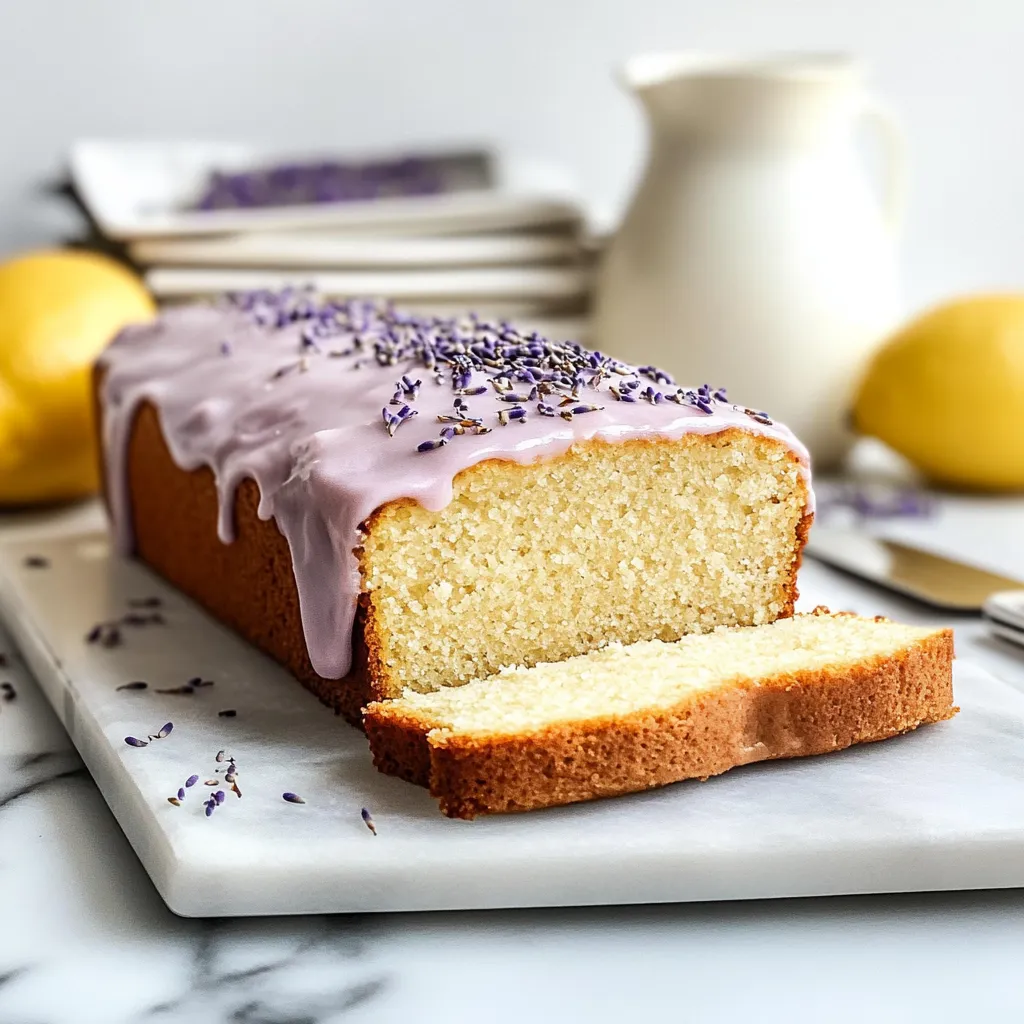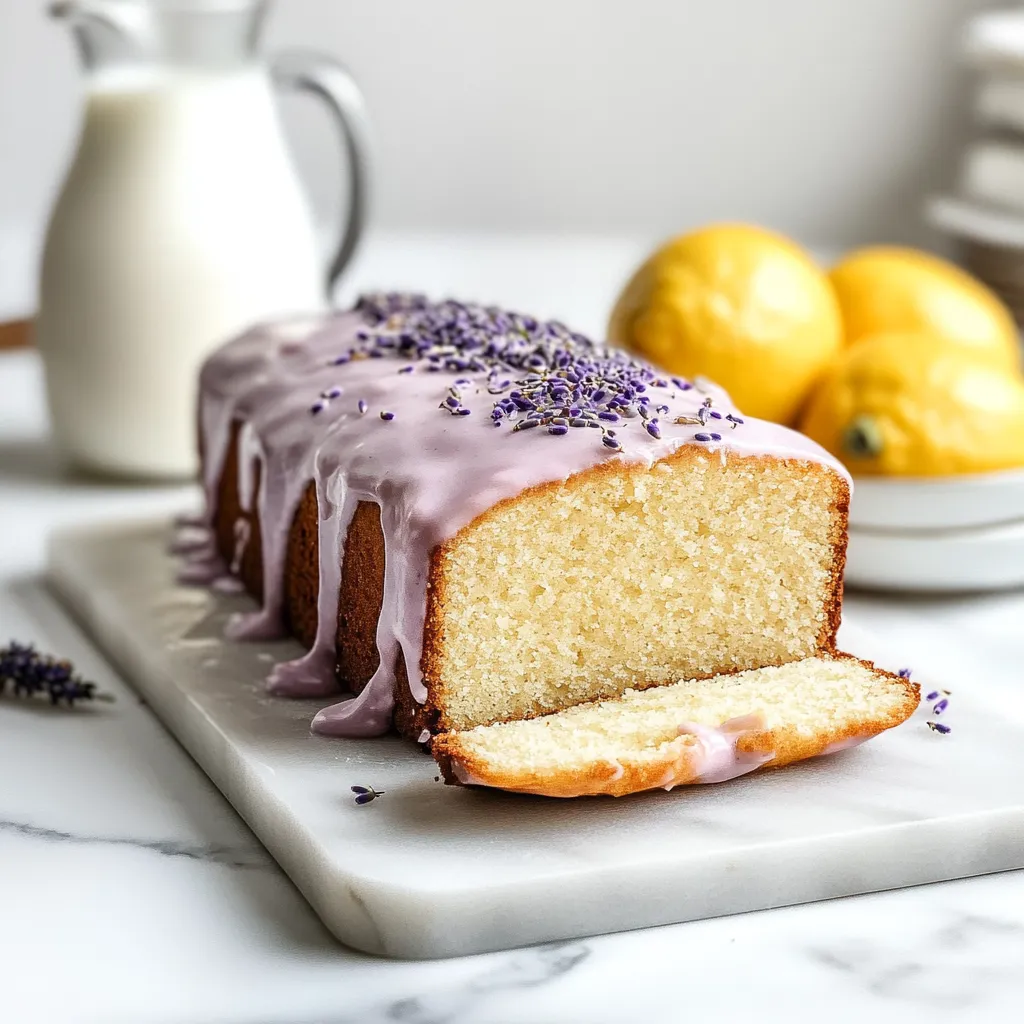 Save
Save
Citrus Lavender Tea Cake brings spring to your table with every bite, mixing bright lemon flavors with soft flowery hints that will wow your taste buds. This fancy loaf gets its amazing taste through careful steps—sugar mixed with lemon peel to squeeze out natural oils, fresh juice for tangy zip, and cooking lavender soaked in warm oil to bring out its gentle flavor. You'll get a soft, juicy cake with just the right texture that gives grown-up flavor without going overboard. Each bite starts with a zesty lemon kick followed by a touch of lavender that stays with you, making this simple loaf something you won't forget in a hurry.
I came up with this while trying to capture what I remembered from my grandma's garden, where lemons and lavender grew next to each other. The first time I brought it to a springtime get-together, everyone stopped talking mid-sentence trying to figure out what that mystery flower taste was behind the lemon. Before dessert was even done, three people had already asked me how to make it, and my brother-in-law—who usually turns his nose up at "fancy" sweets—actually wanted it for his birthday. Now this cake is what I'm known for at spring and summer parties, and it always gets that perfect surprised smile with the first taste.
Perfect Ingredients
- Culinary lavender (2 tablespoons): Gives gentle flower taste without making it soapy
- Canola oil (½ cup): Keeps everything moist while bringing out lavender goodness
- Lemons (3 medium): Adds zippy freshness from both peel and juice
- Granulated sugar (1 cup): Makes it sweet and helps pull oils from lemon peel
- Large eggs (3): Builds the cake's body and makes it rich
- Vanilla extract (1 teaspoon): Adds depth and makes other flavors pop
- All-purpose flour (1¾ cups): Makes the backbone for a soft bite
- Baking powder (2 teaspoons): Makes it puff up just right
- Salt (½ teaspoon): Makes everything taste better and cuts the sweetness
- Greek yogurt (⅓ cup): Keeps it moist with a slight tang that works well with lemon
Loaf Creation
Lavender Blooming
Start with the most important flavor-building part—waking up the lavender. Warm canola oil in a medium pot over medium-high heat for just a minute until it's warm but not smoking hot. Take it off the heat right away and mix in the cooking lavender. Put a tight lid on the pot to trap heat inside, which gently pulls oils from the dried flowers without burning them. Let this sit for at least 30 minutes, though an hour makes it taste even better. The oil will change, getting a light purple color and the nice smell of lavender. Pour it through a fine strainer, gently pushing on the flowers to get every drop of flavored oil out.
Lemon Intensification
While your lavender sits, get your lemons ready using a trick that makes them taste amazing. Grate the lemon skin carefully, staying away from the white bitter part, then put this zest in a bowl with the sugar. Use your fingers to rub the zest into the sugar hard—this breaks open the oil pockets in the peel, letting out all the good smells. Keep going until the sugar turns light yellow and smells super lemony. This simple move turns ordinary lemon flavor into something crazy good. Set this lemon sugar aside while you squeeze juice from the peeled lemons.
Aeration Foundation
In your stand mixer bowl with the whisk part, mix eggs with your lemon sugar and vanilla. Beat on high for a full 3-4 minutes—this isn't too much, it's actually needed. The mix will change a lot, getting three times bigger and turning pale yellow and super fluffy. This air is what makes your cake light. The mix should make ribbons when you lift the whisk, showing you've got enough air in there to make the cake have the perfect texture.
Oil Incorporation
With the mixer going at medium speed, slowly pour in your lavender oil in a thin, steady stream. Adding it bit by bit stops the oil from killing all the air you just put in. The oil should mix in completely, making a blend that will keep your cake moist for days after baking. After all the oil is in, keep beating for another 30 seconds to make sure it's mixed well. The batter will look shiny and smooth, all one texture showing it's properly mixed.
Alternating Additions
In another bowl, mix the flour, baking powder, and salt until they're evenly spread out. Start adding them to your batter by putting in a third of this dry mix, mixing on low just until it disappears. Then add half the yogurt and lemon juice, again mixing just a little. Keep going back and forth—dry, wet, dry, wet, ending with the last third of dry stuff. This careful way of mixing stops the cake from getting tough while making sure everything spreads out evenly. When done, your batter should be smooth and pourable, kind of like thick pancake mix.
Gentle Baking
Pour your batter into a 9x5-inch loaf pan that's been greased well and lined with parchment paper so you can get the cake out easily. The paper should stick up on the long sides like handles for lifting the cake later. Bake in a 350°F oven for 45-50 minutes, until a toothpick stuck in the middle comes out with a few moist crumbs but no wet batter. The top should be golden brown and bounce back when you touch it lightly. This slow baking temperature lets the cake rise evenly without getting a big dome or cracks, giving you a perfectly shaped loaf.
Cooling Patience
Let the cake cool in the pan for exactly 10 minutes—this timing really matters. If you take it out too soon, it won't be strong enough to hold itself up; if you wait too long, the bottom might get soggy from steam. After those 10 minutes, use the paper handles to carefully lift the cake from the pan and put it on a wire rack to cool completely. This could take up to two hours, but waiting gets you the best texture. The cake must be totally cool before you add any glaze or the glaze will just soak in instead of staying on top.

My grandma always told me that cooking with flowers means using a light touch and being patient. "Too much lavender and your food tastes like soap; too little and why even bother?" she'd say while we picked sprigs from her garden. This cake follows her advice about getting the balance right—the lavender doesn't jump out at you but works with the lemon like a quiet hint. Whenever I make this cake, I think about afternoons in her sunny kitchen, where she showed me that the most unforgettable flavors often come from surprising combinations handled with care and respect for what makes each ingredient special.
Serving Suggestions
Cut thin slices of this fancy loaf and serve on small plates with a bit of lightly sweetened whipped cream or crème fraîche. For tea time, have it with Earl Grey or a light white tea that won't fight with the cake's gentle lavender. In summer, add some fresh berries on the side for color and flavors that work well together. For a bigger dessert treat, warm the slices slightly and top with vanilla ice cream, which melts a little into the cake adding creamy richness against the bright lemon and flower notes.
Creative Variations
Switch things up while keeping the same basic method. Swap lavender with fresh thyme or rosemary for an herby flavor that still goes great with lemon. Make a winter version using orange peel and juice instead of lemon, paired with warm spices like cardamom in place of lavender. For special times, toss in a handful of fresh blueberries to the batter just before baking for juicy bursts that go well with both lemon and lavender. You can make a lemon-vanilla version by skipping the lavender and using twice the vanilla for a more familiar but still yummy loaf.
Storage Solutions
This cake stays moist really well when kept in an airtight container at room temperature for up to four days. Many people think the lavender flavor actually gets better on the second day. If you want to keep it longer, wrap single slices tightly in plastic and freeze them for up to three months. Let frozen slices thaw in their wrapper at room temperature for about an hour before eating. If you've put glaze on the cake, try to eat it within two days, as the glaze might soften and soak into the cake if kept longer, though this changes how it looks more than how it tastes.
I've baked tons of loaf cakes over the years, but this lemon lavender one stands out as something I'm really proud of because it hits that sweet spot between familiar and surprising flavors. There's something really cool about watching someone take their first bite—they recognize the lemon right away, then look surprised when they catch the lavender. While some steps might seem fussy, each one has a purpose in building the complex taste that makes this cake so memorable. It reminds me that sometimes the most impressive treats don't need fancy ingredients or complicated decorations, just thoughtful handling of simple things, letting each one shine while working together with the others.

Common Questions About This Recipe
- → What’s the difference between culinary and regular lavender?
- Culinary lavender is milder and specially grown for cooking. You can find it online, at farmer’s markets, or gourmet grocery stores. Always check for 'culinary' or 'food grade' labeling.
- → Can I replace fresh lavender with dried?
- Sure thing! Use about one-third of the amount listed for fresh since dried lavender packs more punch. So, 1 tablespoon fresh equals 1 teaspoon dried.
- → How do I stop my cake from turning out heavy?
- Mix gently once you add the flour, use room temp ingredients, and measure flour by scooping it into the measuring cup instead of using the cup to scoop.
- → Do I need a stand mixer for this cake?
- Nope, you can use a hand mixer or even whisk by hand. Just whip the eggs and sugar well to get a light, fluffy base before adding the rest.
- → When is my cake ready to take out of the oven?
- Stick a toothpick in the middle—it should come out clean or with a crumb or two. The cake should also spring back when touched lightly and pull away from the pan’s edges.
